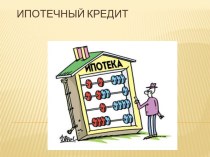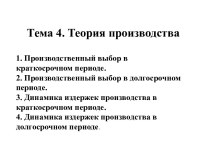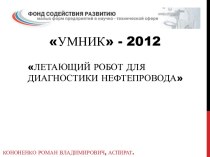- Главная
- Разное
- Бизнес и предпринимательство
- Образование
- Развлечения
- Государство
- Спорт
- Графика
- Культурология
- Еда и кулинария
- Лингвистика
- Религиоведение
- Черчение
- Физкультура
- ИЗО
- Психология
- Социология
- Английский язык
- Астрономия
- Алгебра
- Биология
- География
- Геометрия
- Детские презентации
- Информатика
- История
- Литература
- Маркетинг
- Математика
- Медицина
- Менеджмент
- Музыка
- МХК
- Немецкий язык
- ОБЖ
- Обществознание
- Окружающий мир
- Педагогика
- Русский язык
- Технология
- Физика
- Философия
- Химия
- Шаблоны, картинки для презентаций
- Экология
- Экономика
- Юриспруденция
Что такое findslide.org?
FindSlide.org - это сайт презентаций, докладов, шаблонов в формате PowerPoint.
Обратная связь
Email: Нажмите что бы посмотреть
Презентация на тему Consequences of EC 5 for Danish best practise
Содержание
- 2. Introduction 1Danish Timber Code has approached Eurocode
- 3. Introduction 1Danish Timber Code has approached Eurocode
- 4. Introduction 1Danish Timber Code has approached Eurocode
- 5. Introduction 2Numerous problems using Eurocode 5 found
- 6. Introduction 2Numerous problems using Eurocode 5 found
- 7. Introduction 2Numerous problems using Eurocode 5 found
- 8. Strength parametersDowel (FJohansen): combination ofEmbedment strength of
- 9. Strength parametersDowel (FJohansen): combination ofEmbedment strength of
- 10. Strength parametersDowel (FJohansen): combination ofEmbedment strength of
- 11. Density 1Well established that strength of fasteners
- 12. Density 1Well established that strength of fasteners
- 13. Density 2Strength class for Nordic timber is
- 14. Axially loaded fastenersHead pull-throughWithdrawal
- 15. Head pull-throughEurocode value formally given only for smooth nailsVery low strength given
- 16. Head pull-throughEurocode value formally given only for
- 17. Head pull-throughEurocode value formally given only for
- 18. Correction of measured strength for densityExample: Head
- 19. Correction of measured strength for densityExample: Head
- 20. Withdrawal – smooth nailsStrength parameters given are
- 21. Withdrawal – smooth nailsStrength parameters given are
- 22. Withdrawal – smooth nailsStrength parameters given are
- 23. Roof of steel plates300 m2 blew offWind
- 24. CauseBattens fastened with smooth nails (square and rusty)
- 25. Withdrawal – threaded nailsStrength parameter must be
- 26. Withdrawal – threaded nailsStrength parameter must be
- 27. Withdrawal – screws 1Very complicated formula given
- 28. Withdrawal – screws 2No significant dependency on
- 29. Laterally loaded fastenersNails, timber to timberScrews, timber to timberSteel to timber
- 30. Laterally loaded nails – timber to timberEurocode:Dowel
- 32. Laterally loaded screws Eurocode still focus on
- 33. Laterally loaded screws Eurocode still focus on
- 34. Laterally loaded screws Eurocode still focus on
- 35. Measured embedment strength for screwsdroot / d
- 36. Laterally loaded nails - steel to timberEurocode:Separate
- 38. Higher values will appear in an ETA-agreement
- 39. Spacing parallel to grainIf fasteners not staggered
- 40. Spacing parallel to grainIf fasteners not staggered
- 41. Common connection not allowed by EC545 mm
- 42. Conclusions 1Initial Type Testing (ITT) is necessary
- 43. Conclusions 1Initial Type Testing (ITT) is necessary
- 44. Conclusions 2Minimum penetration lengths appears very conservativeCorrection
- 45. Conclusions 2Minimum penetration lengths appears very conservativeCorrection
- 46. Скачать презентацию
- 47. Похожие презентации
Introduction 1Danish Timber Code has approached Eurocode 5 – except for fastenersEurocodes replaces Danish Codes from 1 Jan 2009
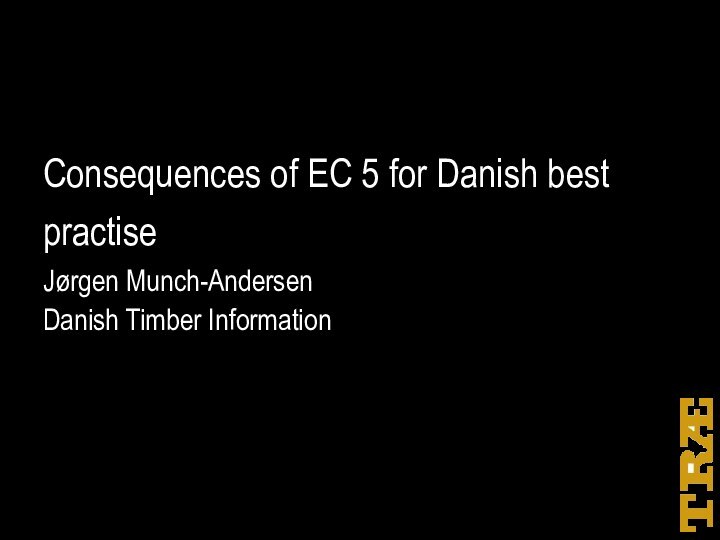
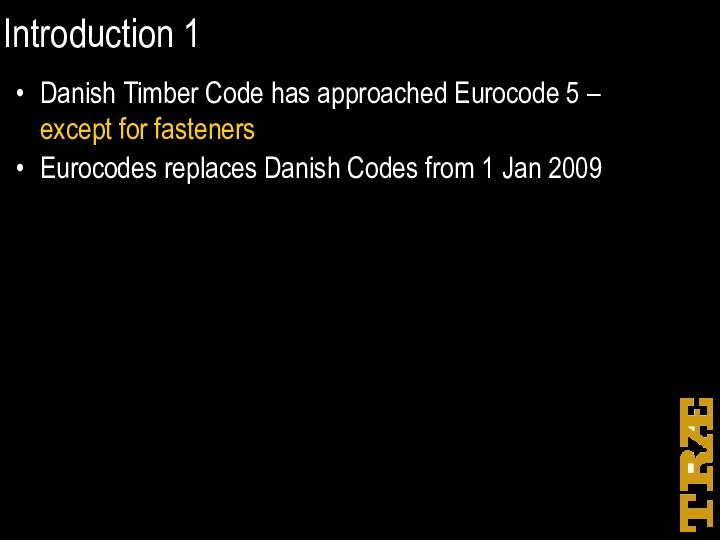
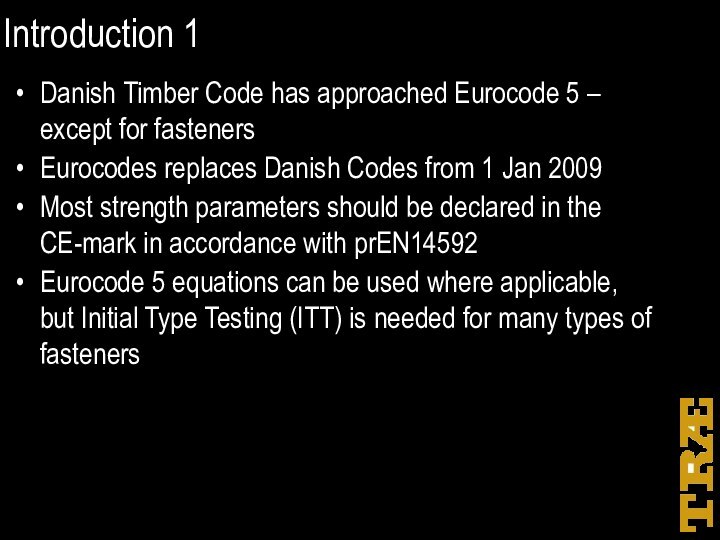
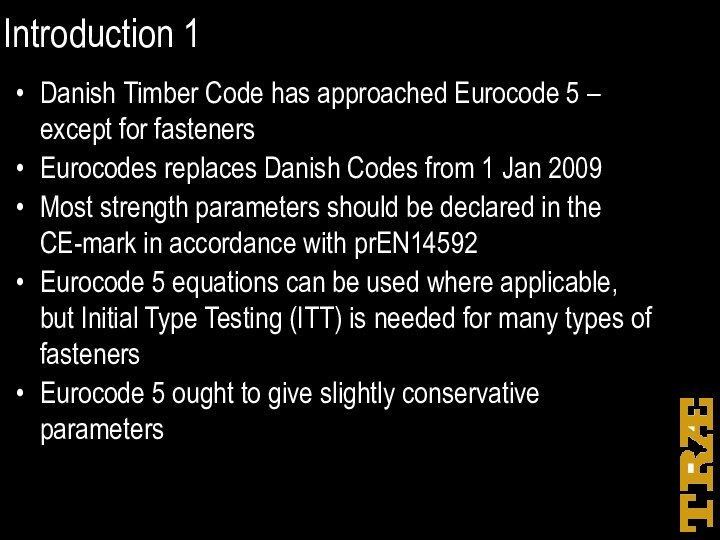
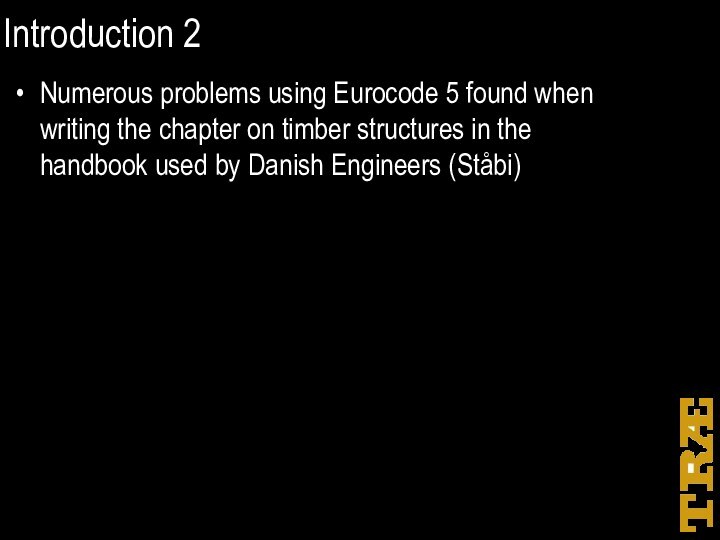

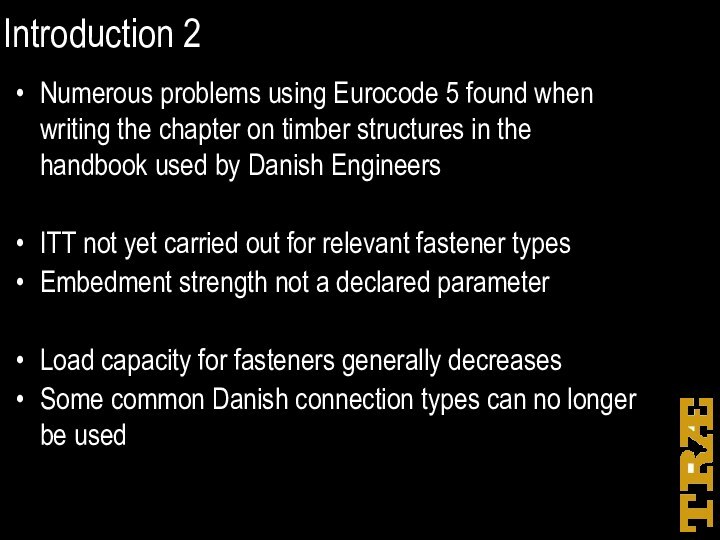
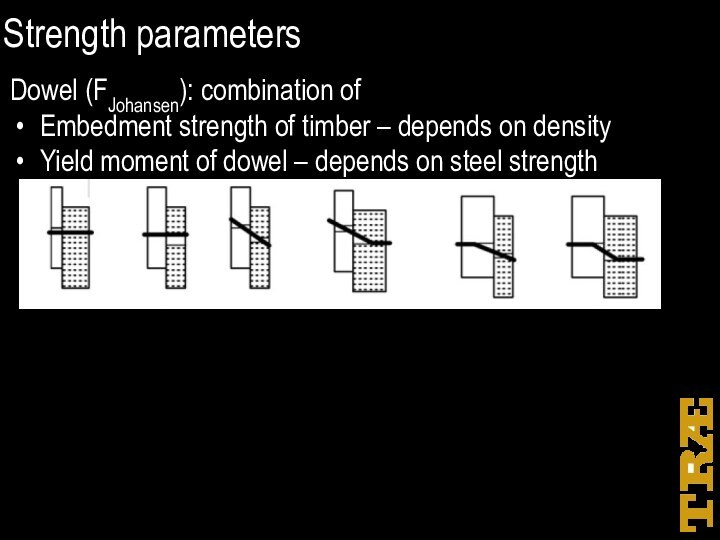
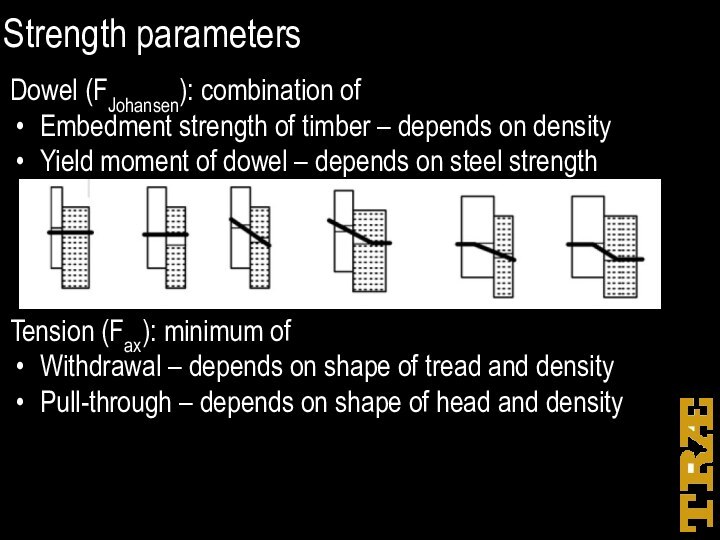
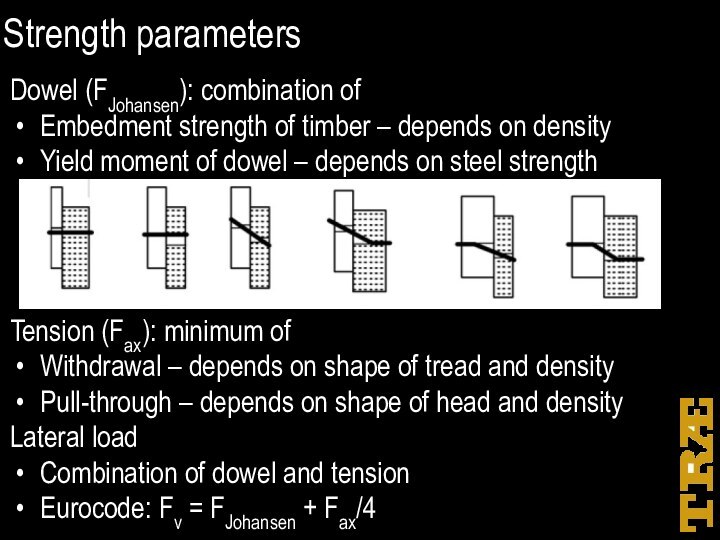
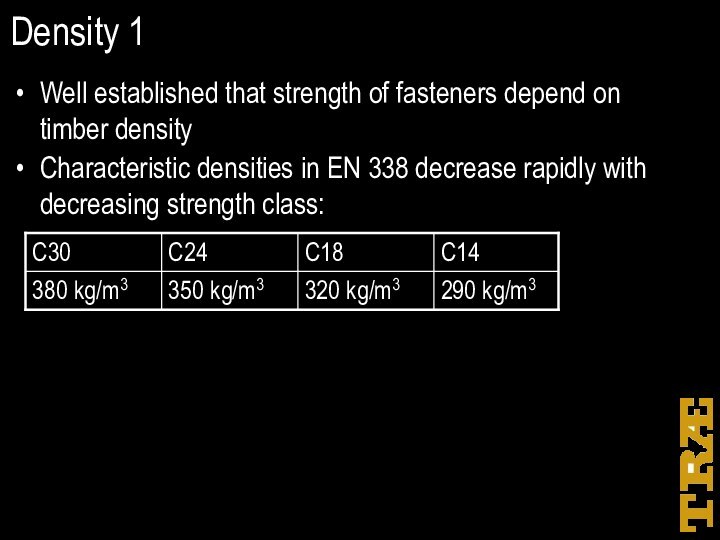
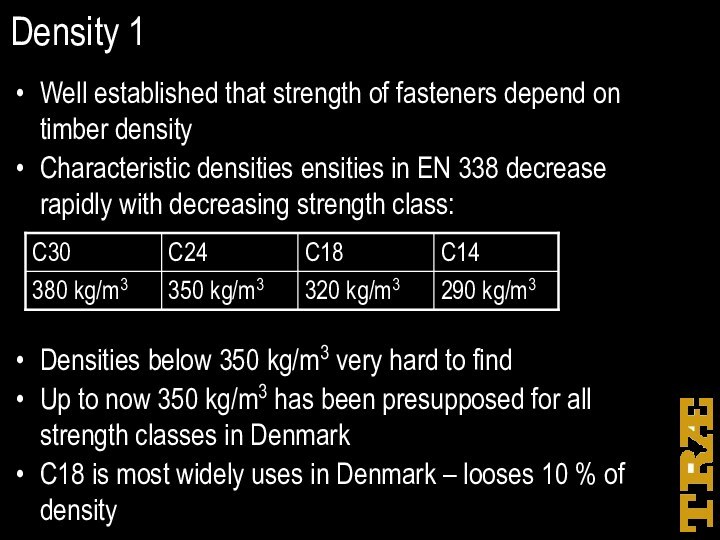
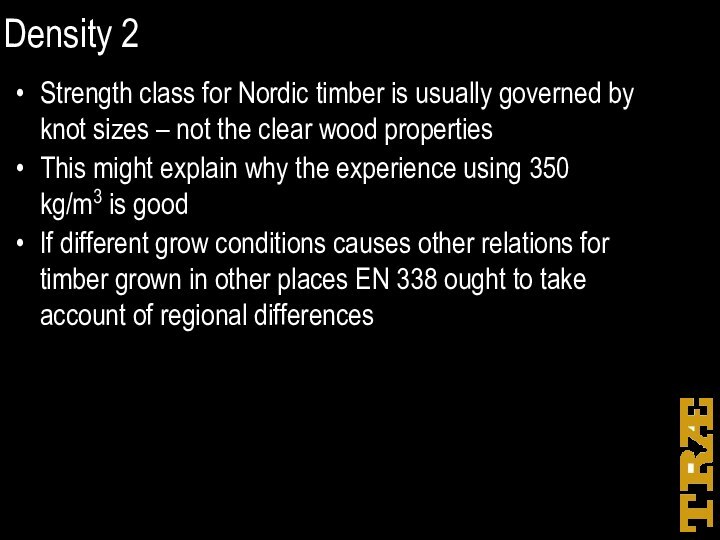
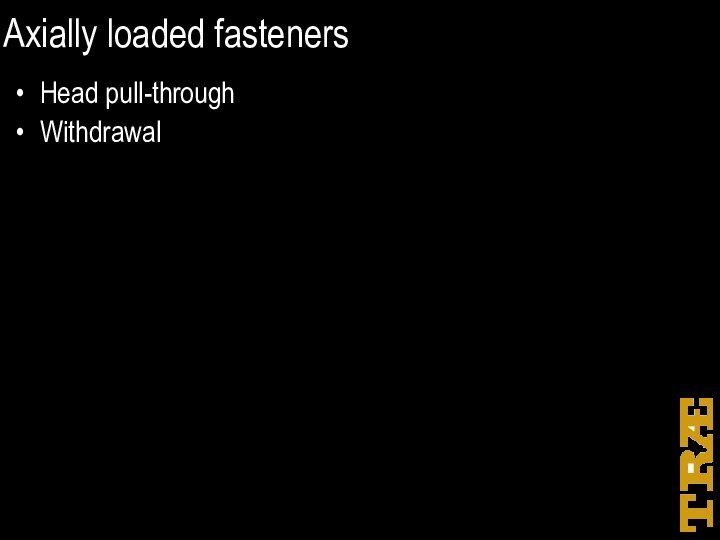
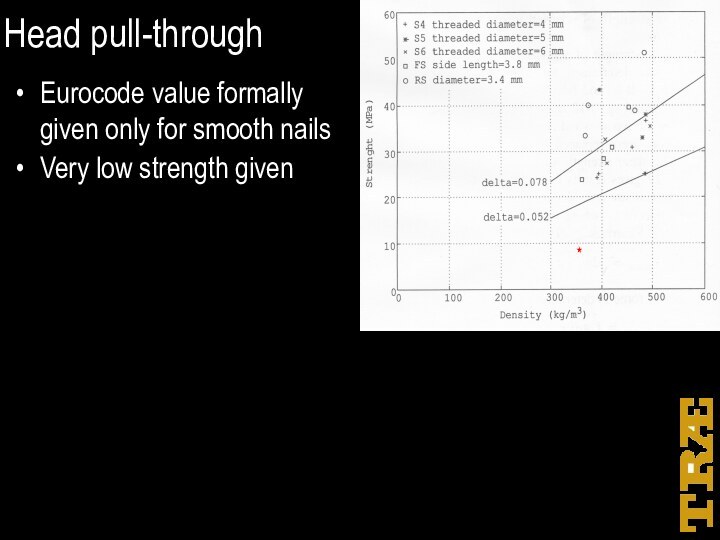
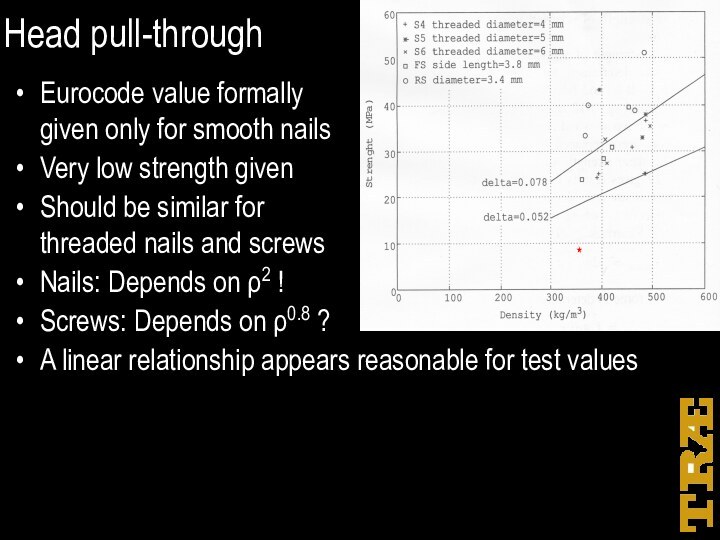
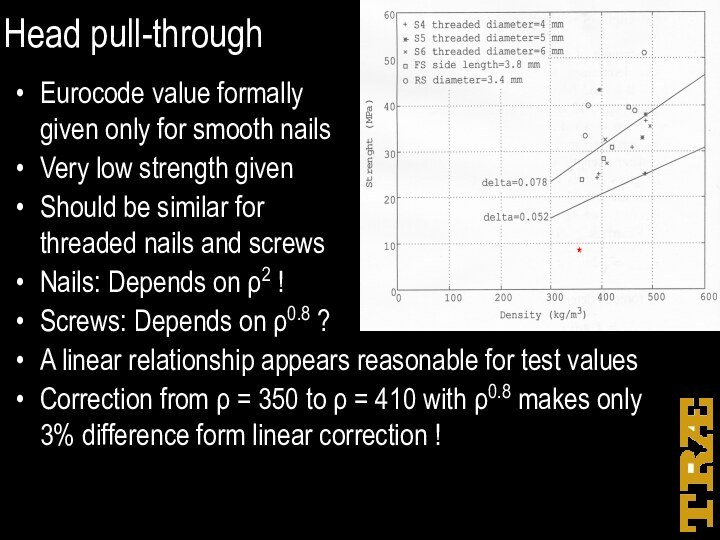
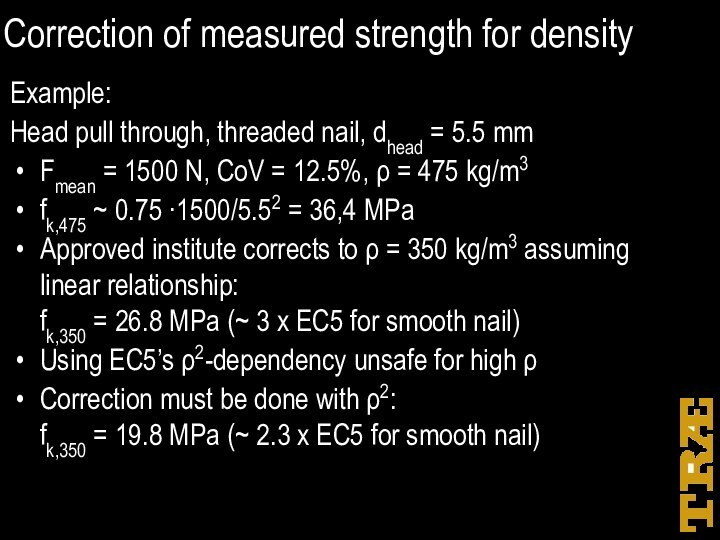
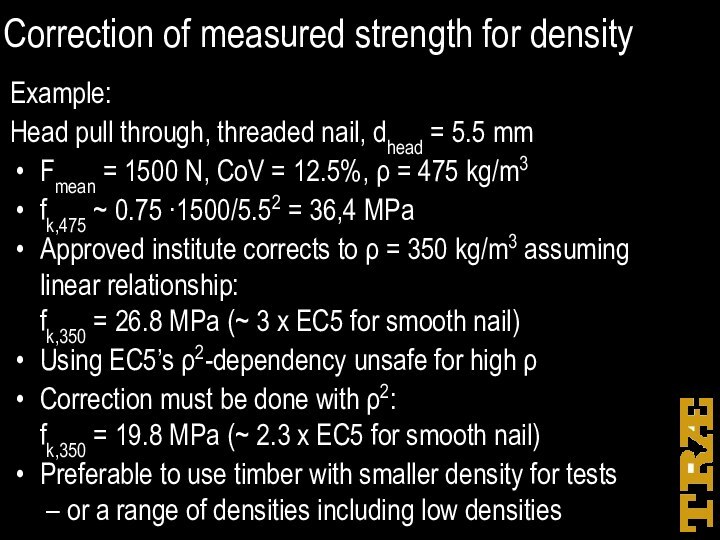
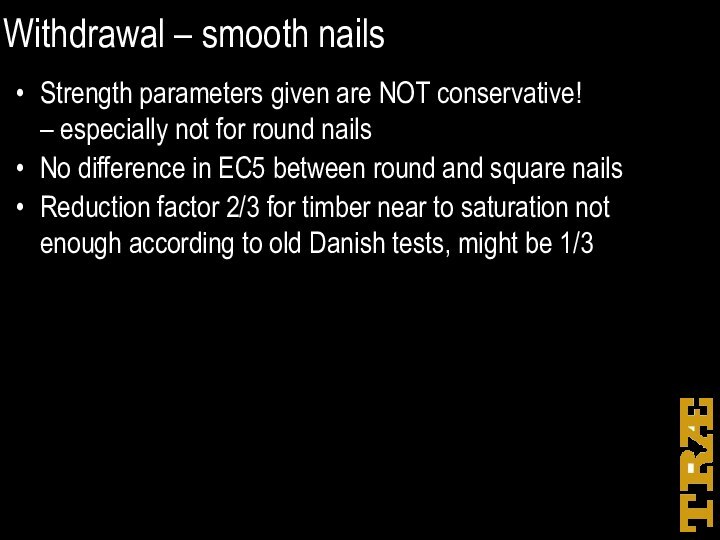
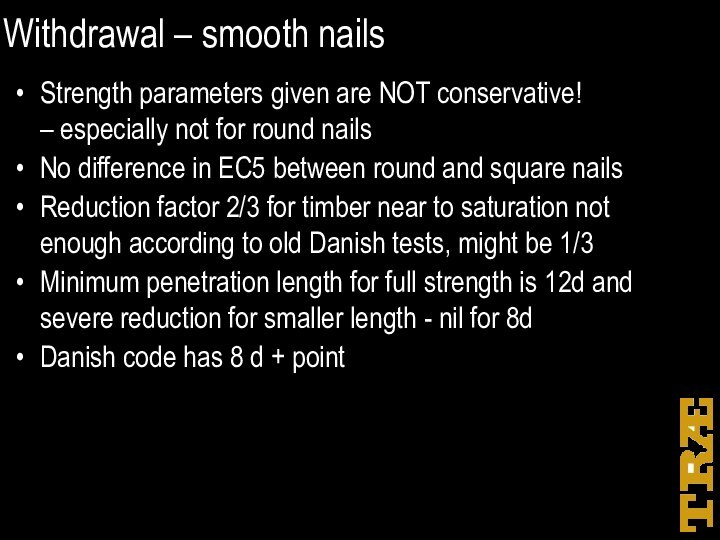
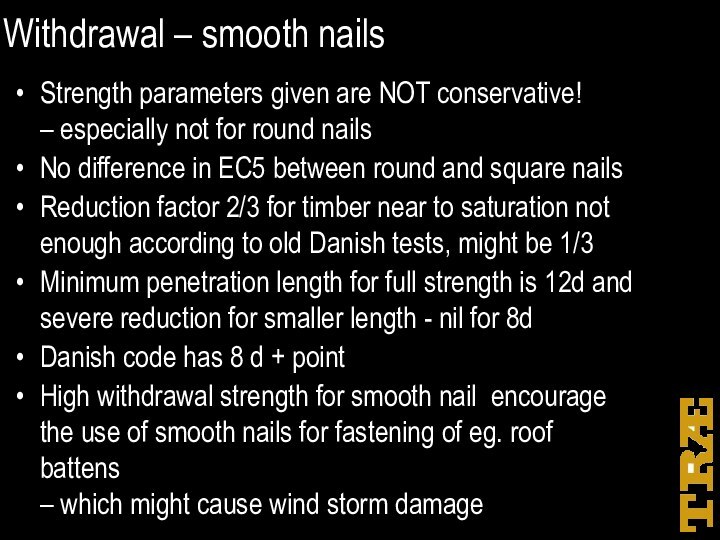
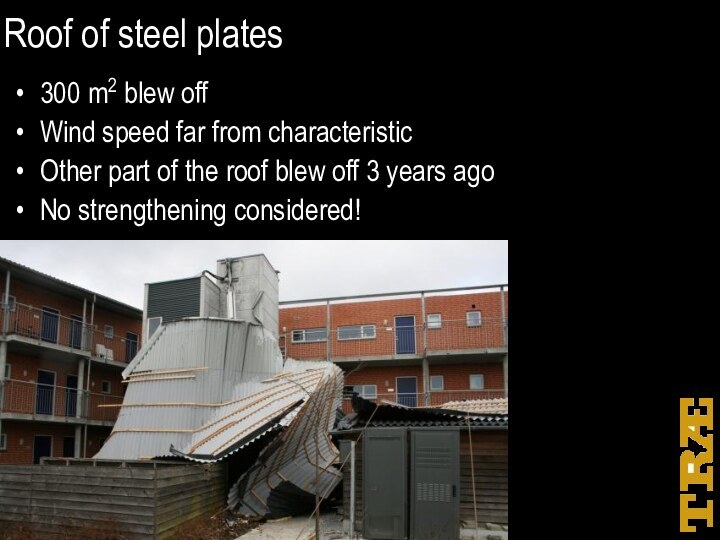
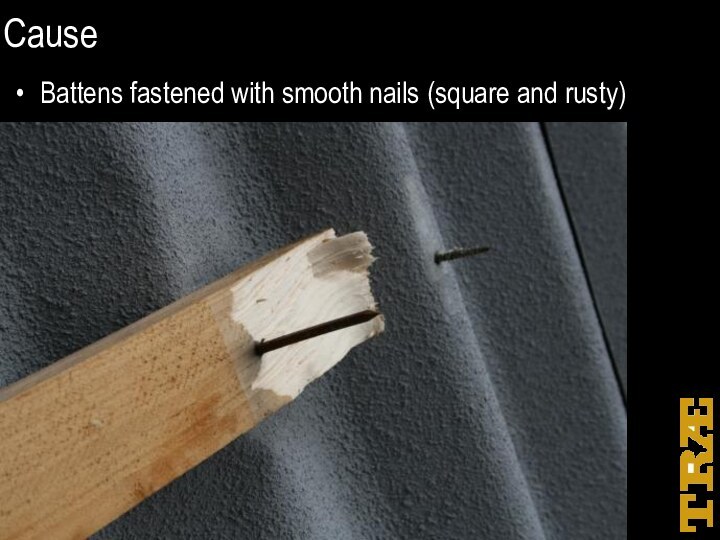
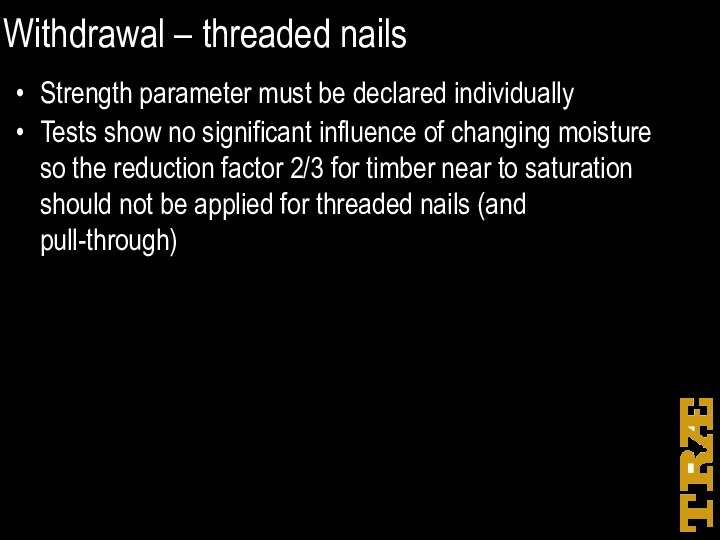
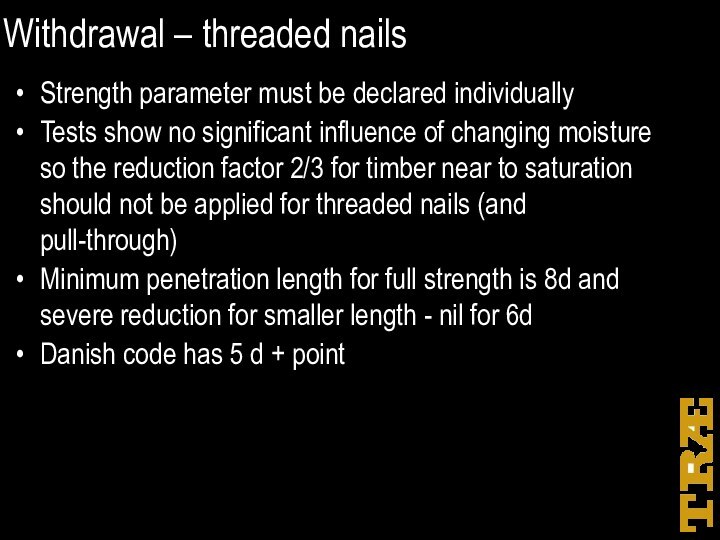

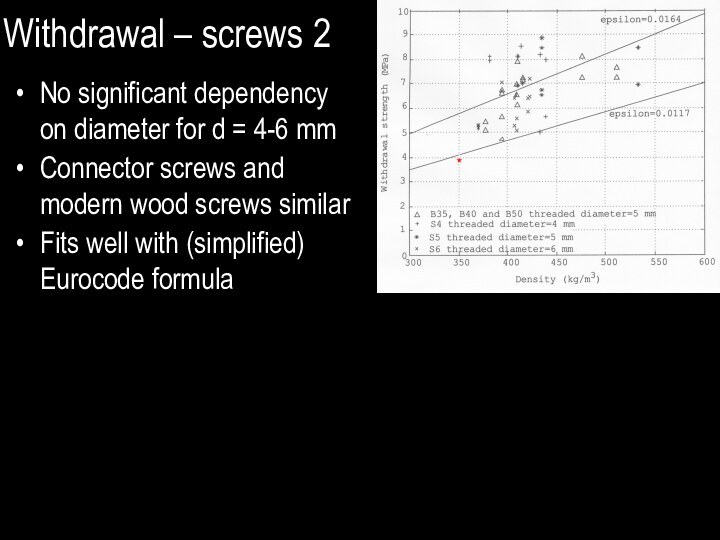
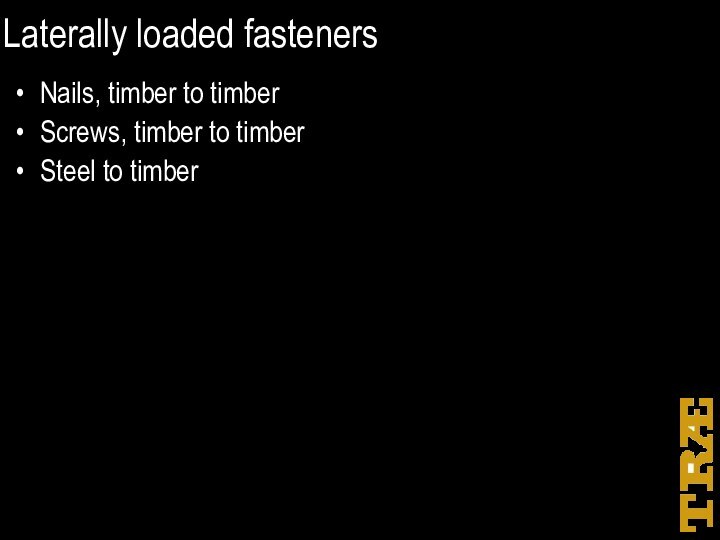
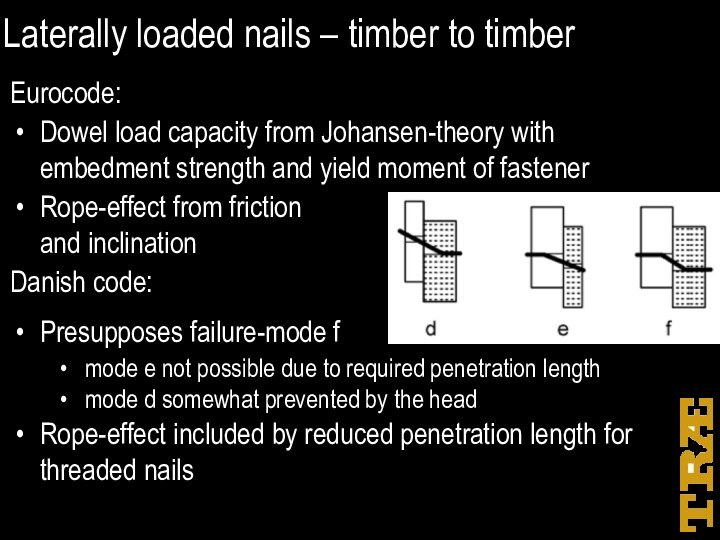
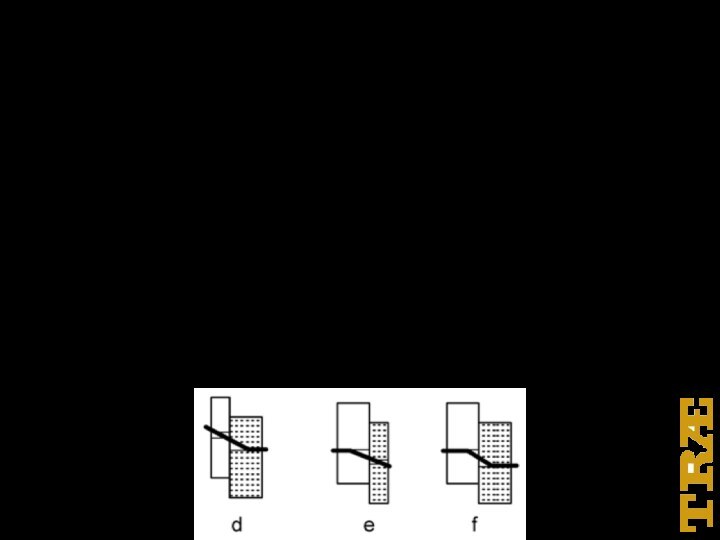
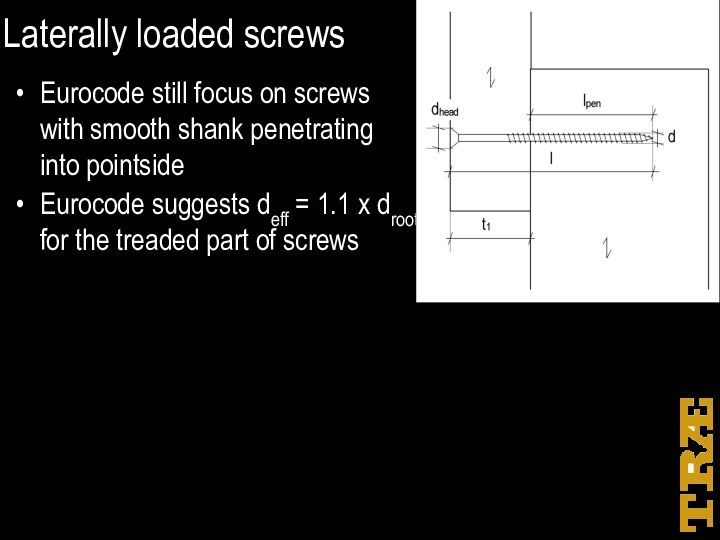
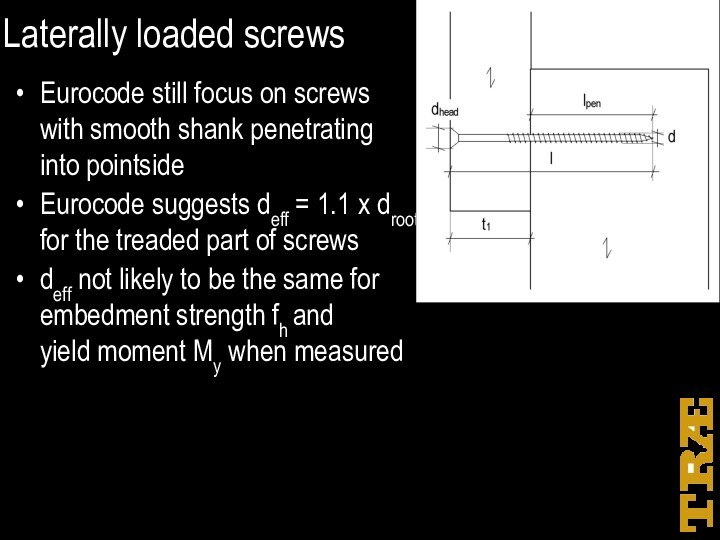
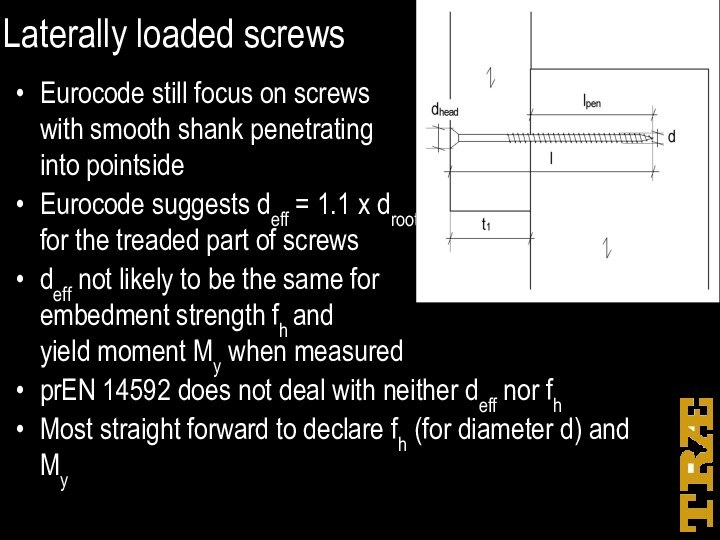
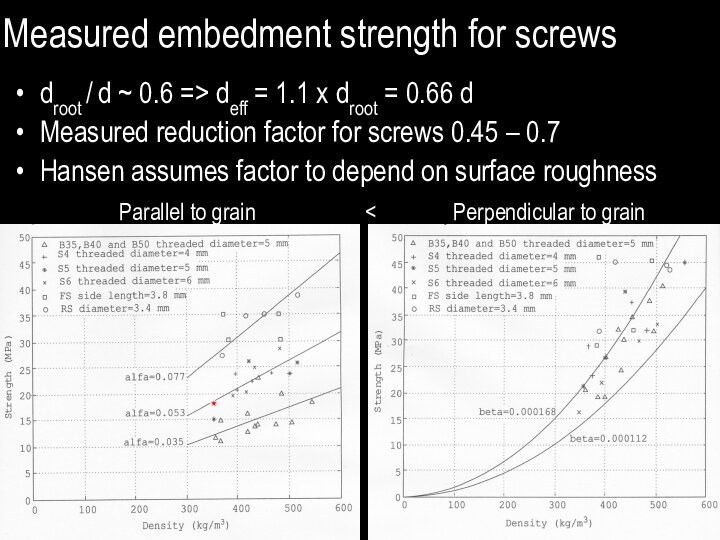
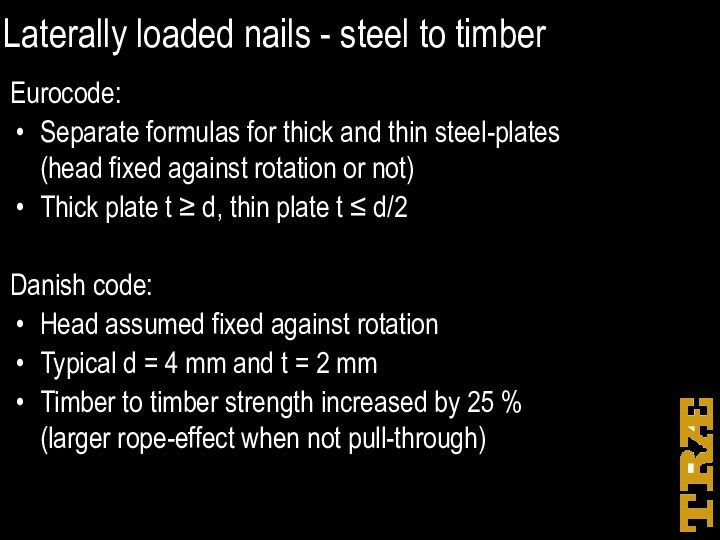

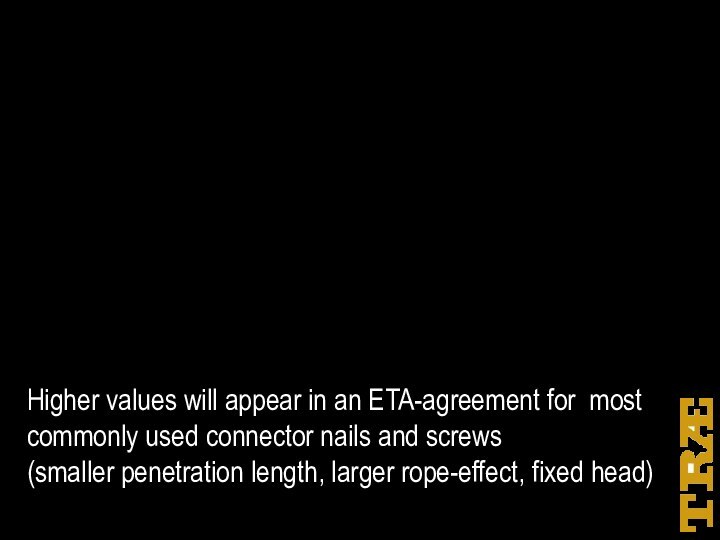
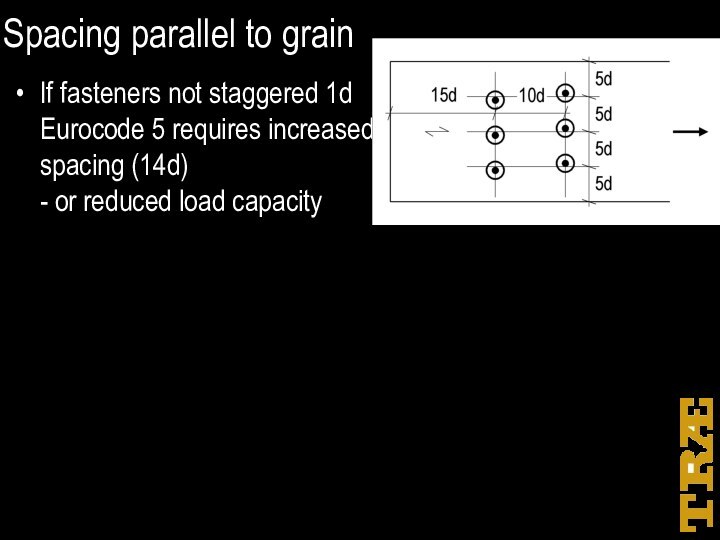
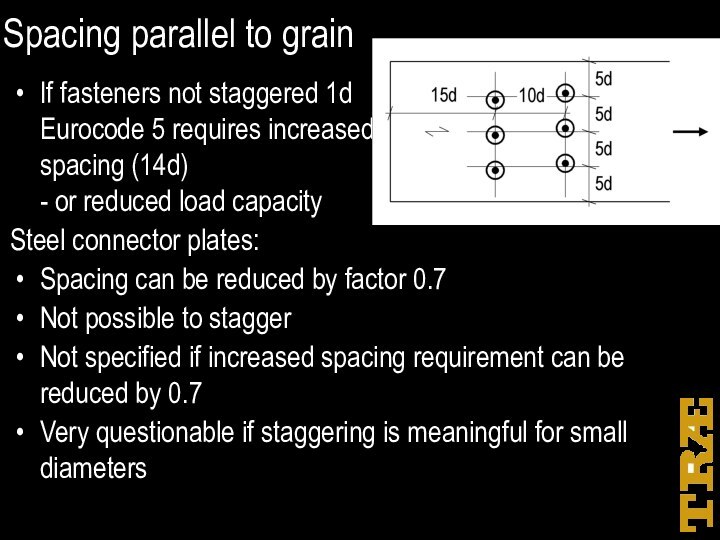
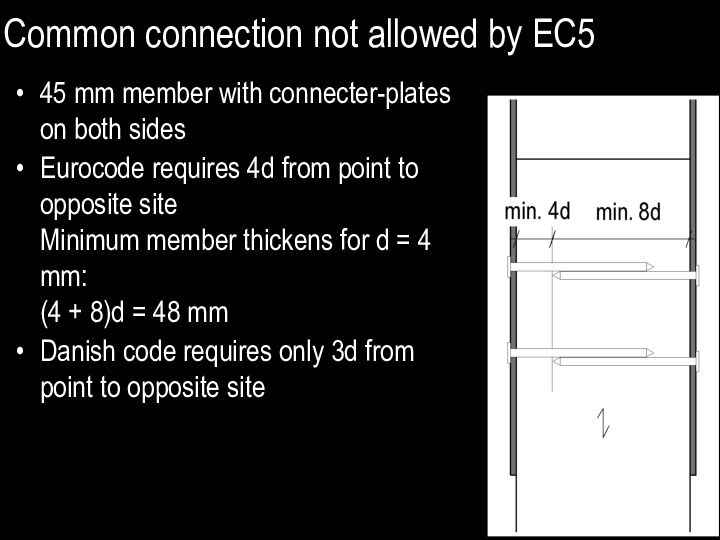
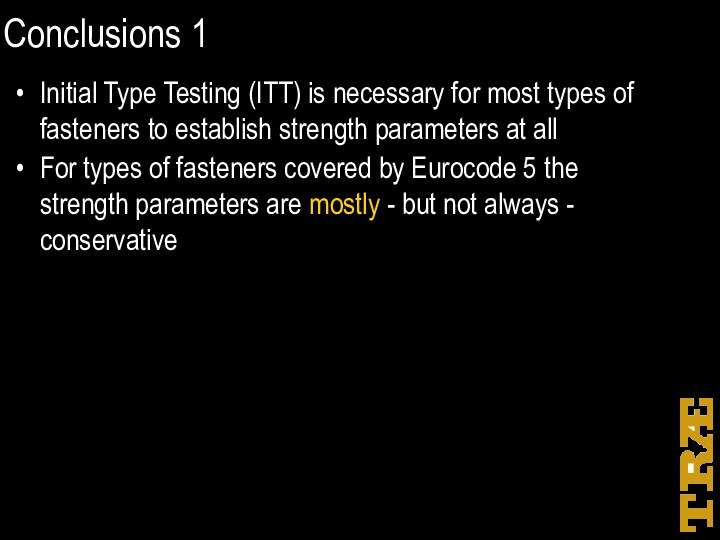
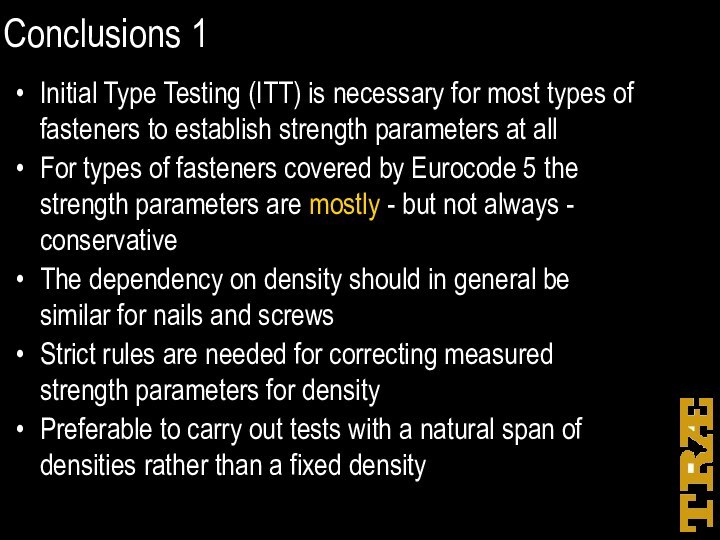
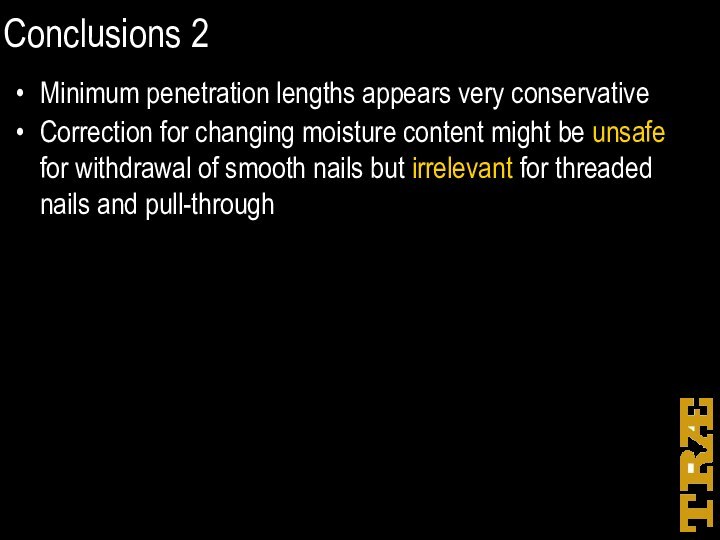
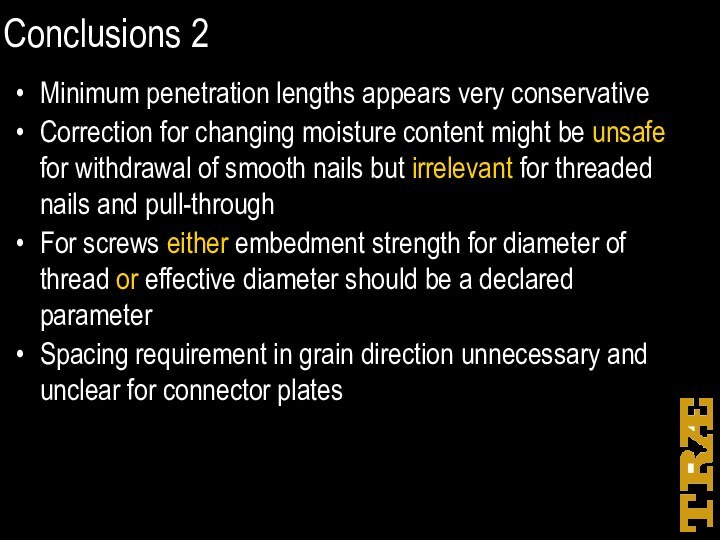
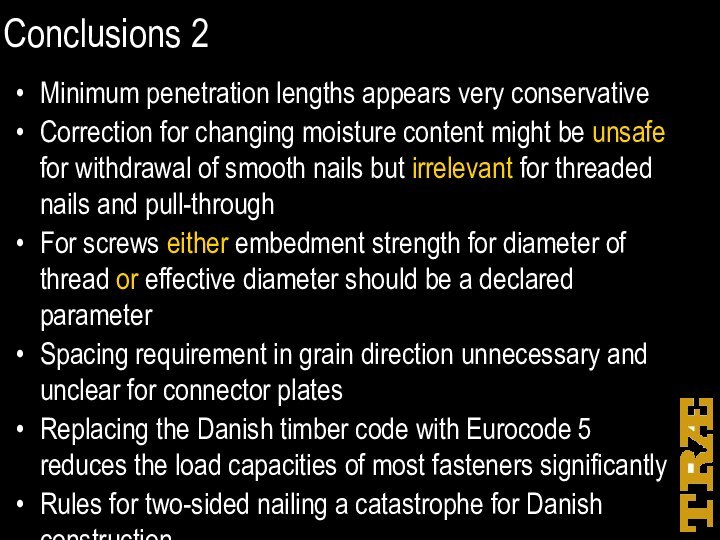
Слайд 3
Introduction 1
Danish Timber Code has approached Eurocode 5
– except for fasteners
Eurocodes replaces Danish Codes from 1
Jan 2009Most strength parameters should be declared in the CE-mark in accordance with prEN14592
Eurocode 5 equations can be used where applicable, but Initial Type Testing (ITT) is needed for many types of fasteners
Слайд 4
Introduction 1
Danish Timber Code has approached Eurocode 5
– except for fasteners
Eurocodes replaces Danish Codes from 1
Jan 2009Most strength parameters should be declared in the CE-mark in accordance with prEN14592
Eurocode 5 equations can be used where applicable, but Initial Type Testing (ITT) is needed for many types of fasteners
Eurocode 5 ought to give slightly conservative parameters
Слайд 5
Introduction 2
Numerous problems using Eurocode 5 found when
writing the chapter on timber structures in the handbook
used by Danish Engineers (Ståbi)
Слайд 6
Introduction 2
Numerous problems using Eurocode 5 found when
writing the chapter on timber structures in the handbook
used by Danish EngineersITT not yet carried out for relevant fastener types
Embedment strength not a declared parameter
Слайд 7
Introduction 2
Numerous problems using Eurocode 5 found when
writing the chapter on timber structures in the handbook
used by Danish EngineersITT not yet carried out for relevant fastener types
Embedment strength not a declared parameter
Load capacity for fasteners generally decreases
Some common Danish connection types can no longer be used
Слайд 8
Strength parameters
Dowel (FJohansen): combination of
Embedment strength of timber
– depends on density
Yield moment of dowel – depends
on steel strength
Слайд 9
Strength parameters
Dowel (FJohansen): combination of
Embedment strength of timber
– depends on density
Yield moment of dowel – depends
on steel strengthTension (Fax): minimum of
Withdrawal – depends on shape of tread and density
Pull-through – depends on shape of head and density
Слайд 10
Strength parameters
Dowel (FJohansen): combination of
Embedment strength of timber
– depends on density
Yield moment of dowel – depends
on steel strengthTension (Fax): minimum of
Withdrawal – depends on shape of tread and density
Pull-through – depends on shape of head and density
Lateral load
Combination of dowel and tension
Eurocode: Fv = FJohansen + Fax/4
Слайд 11
Density 1
Well established that strength of fasteners depend
on timber density
Characteristic densities in EN 338 decrease rapidly
with decreasing strength class:
Слайд 12
Density 1
Well established that strength of fasteners depend
on timber density
Characteristic densities ensities in EN 338 decrease
rapidly with decreasing strength class:Densities below 350 kg/m3 very hard to find
Up to now 350 kg/m3 has been presupposed for all strength classes in Denmark
C18 is most widely uses in Denmark – looses 10 % of density
Слайд 13
Density 2
Strength class for Nordic timber is usually
governed by knot sizes – not the clear wood
propertiesThis might explain why the experience using 350 kg/m3 is good
If different grow conditions causes other relations for timber grown in other places EN 338 ought to take account of regional differences
Слайд 15
Head pull-through
Eurocode value formally
given only for smooth nails
Very
low strength given
Слайд 16
Head pull-through
Eurocode value formally
given only for smooth nails
Very
low strength given
Should be similar for
threaded nails and
screwsNails: Depends on ρ2 !
Screws: Depends on ρ0.8 ?
A linear relationship appears reasonable for test values
Слайд 17
Head pull-through
Eurocode value formally
given only for smooth nails
Very
low strength given
Should be similar for
threaded nails and
screwsNails: Depends on ρ2 !
Screws: Depends on ρ0.8 ?
A linear relationship appears reasonable for test values
Correction from ρ = 350 to ρ = 410 with ρ0.8 makes only 3% difference form linear correction !
Слайд 18
Correction of measured strength for density
Example:
Head pull
through, threaded nail, dhead = 5.5 mm
Fmean = 1500
N, CoV = 12.5%, ρ = 475 kg/m3fk,475 ~ 0.75 ∙1500/5.52 = 36,4 MPa
Approved institute corrects to ρ = 350 kg/m3 assuming linear relationship: fk,350 = 26.8 MPa (~ 3 x EC5 for smooth nail)
Using EC5’s ρ2-dependency unsafe for high ρ
Correction must be done with ρ2: fk,350 = 19.8 MPa (~ 2.3 x EC5 for smooth nail)
Слайд 19
Correction of measured strength for density
Example:
Head pull
through, threaded nail, dhead = 5.5 mm
Fmean = 1500
N, CoV = 12.5%, ρ = 475 kg/m3fk,475 ~ 0.75 ∙1500/5.52 = 36,4 MPa
Approved institute corrects to ρ = 350 kg/m3 assuming linear relationship: fk,350 = 26.8 MPa (~ 3 x EC5 for smooth nail)
Using EC5’s ρ2-dependency unsafe for high ρ
Correction must be done with ρ2: fk,350 = 19.8 MPa (~ 2.3 x EC5 for smooth nail)
Preferable to use timber with smaller density for tests – or a range of densities including low densities
Слайд 20
Withdrawal – smooth nails
Strength parameters given are NOT
conservative!
– especially not for round nails
No difference in
EC5 between round and square nailsReduction factor 2/3 for timber near to saturation not enough according to old Danish tests, might be 1/3
Слайд 21
Withdrawal – smooth nails
Strength parameters given are NOT
conservative!
– especially not for round nails
No difference in
EC5 between round and square nailsReduction factor 2/3 for timber near to saturation not enough according to old Danish tests, might be 1/3
Minimum penetration length for full strength is 12d and severe reduction for smaller length - nil for 8d
Danish code has 8 d + point
Слайд 22
Withdrawal – smooth nails
Strength parameters given are NOT
conservative!
– especially not for round nails
No difference in
EC5 between round and square nailsReduction factor 2/3 for timber near to saturation not enough according to old Danish tests, might be 1/3
Minimum penetration length for full strength is 12d and severe reduction for smaller length - nil for 8d
Danish code has 8 d + point
High withdrawal strength for smooth nail encourage the use of smooth nails for fastening of eg. roof battens – which might cause wind storm damage
Слайд 23
Roof of steel plates
300 m2 blew off
Wind speed
far from characteristic
Other part of the roof blew off
3 years agoNo strengthening considered!
Слайд 25
Withdrawal – threaded nails
Strength parameter must be declared
individually
Tests show no significant influence of changing moisture so
the reduction factor 2/3 for timber near to saturation should not be applied for threaded nails (and pull-through)
Слайд 26
Withdrawal – threaded nails
Strength parameter must be declared
individually
Tests show no significant influence of changing moisture so
the reduction factor 2/3 for timber near to saturation should not be applied for threaded nails (and pull-through)Minimum penetration length for full strength is 8d and severe reduction for smaller length - nil for 6d
Danish code has 5 d + point
Слайд 27
Withdrawal – screws 1
Very complicated formula given and
only for “old fashioned” screws with d = 6-12
mmThe simple formula 0.035 d ℓpen ρ can replace within 10% for d = 6-10 mm
ITT will give a single strength parameter, independent on e.g. length. A possible diameter dependency will be included in declared parameter
Separate spacing requirements for withdrawal and only for timber thickness 12d (which members thickness?)
Слайд 28
Withdrawal – screws 2
No significant dependency on diameter
for d = 4-6 mm
Connector screws and modern wood
screws similarFits well with (simplified) Eurocode formula
Слайд 30
Laterally loaded nails – timber to timber
Eurocode:
Dowel load
capacity from Johansen-theory with embedment strength and yield moment
of fastenerRope-effect from friction and inclination
Danish code:
Presupposes failure-mode f
mode e not possible due to required penetration length
mode d somewhat prevented by the head
Rope-effect included by reduced penetration length for threaded nails
Слайд 32
Laterally loaded screws
Eurocode still focus on screws
with smooth shank penetrating
into pointside
Eurocode suggests deff =
1.1 x droot
for the treaded part of screws
Слайд 33
Laterally loaded screws
Eurocode still focus on screws
with smooth shank penetrating
into pointside
Eurocode suggests deff =
1.1 x droot
for the treaded part of screwsdeff not likely to be the same for embedment strength fh and yield moment My when measured
Слайд 34
Laterally loaded screws
Eurocode still focus on screws
with smooth shank penetrating
into pointside
Eurocode suggests deff =
1.1 x droot
for the treaded part of screwsdeff not likely to be the same for embedment strength fh and yield moment My when measured
prEN 14592 does not deal with neither deff nor fh
Most straight forward to declare fh (for diameter d) and My
Слайд 35
Measured embedment strength for screws
droot / d ~
0.6 => deff = 1.1 x droot = 0.66
dMeasured reduction factor for screws 0.45 – 0.7
Hansen assumes factor to depend on surface roughness
Parallel to grain < Perpendicular to grain
Слайд 36
Laterally loaded nails - steel to timber
Eurocode:
Separate formulas
for thick and thin steel-plates (head fixed against rotation or
not)Thick plate t ≥ d, thin plate t ≤ d/2
Danish code:
Head assumed fixed against rotation
Typical d = 4 mm and t = 2 mm
Timber to timber strength increased by 25 % (larger rope-effect when not pull-through)
Слайд 38 Higher values will appear in an ETA-agreement for
most commonly used connector nails and screws (smaller penetration length,
larger rope-effect, fixed head)
Слайд 39
Spacing parallel to grain
If fasteners not staggered 1d
Eurocode 5 requires increased spacing (14d) - or reduced
load capacity
Слайд 40
Spacing parallel to grain
If fasteners not staggered 1d
Eurocode 5 requires increased spacing (14d) - or reduced
load capacitySteel connector plates:
Spacing can be reduced by factor 0.7
Not possible to stagger
Not specified if increased spacing requirement can be reduced by 0.7
Very questionable if staggering is meaningful for small diameters
Слайд 41
Common connection not allowed by EC5
45 mm member
with connecter-plates
on both sides
Eurocode requires 4d from
point to
opposite site
Minimum member thickens for d = 4 mm:
(4 + 8)d = 48 mmDanish code requires only 3d from point to opposite site
Слайд 42
Conclusions 1
Initial Type Testing (ITT) is necessary for
most types of fasteners to establish strength parameters at
allFor types of fasteners covered by Eurocode 5 the strength parameters are mostly - but not always - conservative
Слайд 43
Conclusions 1
Initial Type Testing (ITT) is necessary for
most types of fasteners to establish strength parameters at
allFor types of fasteners covered by Eurocode 5 the strength parameters are mostly - but not always - conservative
The dependency on density should in general be similar for nails and screws
Strict rules are needed for correcting measured strength parameters for density
Preferable to carry out tests with a natural span of densities rather than a fixed density
Слайд 44
Conclusions 2
Minimum penetration lengths appears very conservative
Correction for
changing moisture content might be unsafe for withdrawal of
smooth nails but irrelevant for threaded nails and pull-through
Слайд 45
Conclusions 2
Minimum penetration lengths appears very conservative
Correction for
changing moisture content might be unsafe for withdrawal of
smooth nails but irrelevant for threaded nails and pull-throughFor screws either embedment strength for diameter of thread or effective diameter should be a declared parameter
Spacing requirement in grain direction unnecessary and unclear for connector plates








